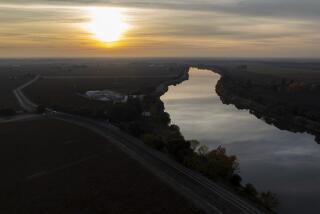Newton: Refighting California’s water war
When Gov. Jerry Brown wrapped up his tenure last time through, he left a huge unresolved question for California: In the wake of a failed 1982 initiative to fund the so-called peripheral canal, how would the state distribute and safeguard its water supply?
How to maximize the water supply and allocate it fairly has been debated often in the years since without producing a solution. But it now looks as if Brown intends to finish up this piece of unresolved business.
Earlier this month, state water officials presented him with the basics of a plan that would have profound implications for the future of California, as well as the legacy of its governor. If it is approved by the relevant state and federal agencies and overcomes any legal challenges, it would reroute water through the Sacramento-San Joaquin River Delta, diverting freshwater around the marshy area that sits below sea level and transporting it, either by tunnel or canal, into the State Water Project, which serves parts of the San Francisco Bay Area and Southern California. The plan calls for extensive habitat restoration as well.
That sounds simple enough, but even the hint of it resurrects an exceptionally divisive debate. In the early 1980s, Brown’s proposal for a peripheral canal — which had much in common with the project now being proposed — split Californians along geographic lines. Wildly popular in Southern California, the idea was reviled in the north. I was in high school in Palo Alto when it first began to circulate; my friends and neighbors could not mention the proposal without deriding it as a Los Angeles “water grab.” Some Northern Californians even advocated splitting the state in two.
Proposition 9, the bond measure that would have paid for the canal, went down to a narrow defeat that highlighted the tensions between north and south. Los Angeles County backed the measure by 61% to 39%; in Northern California, meanwhile, more than 90% of voters in many counties opposed it.
This time out, the regional dispute is far more muted — and for good reason. At its core, this is not an attempt to draw more water from north to south but rather to shore up a vulnerable system whose failure could cast the state into chaos.
Protecting that system is the central preoccupation of the Metropolitan Water District of Southern California, and it has played a key role in shaping the $16-billion proposal, most of which it would pay for with increased rates to its customers. They won’t like that, but the project is, in the words of Assistant General Manager Roger K. Patterson, an “insurance policy” protecting the state’s water supply against an earthquake that could destroy the levees that keep seawater out of the delta. Such an earthquake could flood the delta and wipe it out as a source of freshwater within hours. Experts say it might take three years to restore supply, in the meantime depriving both Southern California and the Bay Area of almost a third of their water supply.
Patterson and his boss, General Manager Jeffrey Kightlinger, laid out that scenario in a recent interview, surrounded by the history of this issue. We spoke in Kightlinger’s office, its walls and tabletops covered with mementos of California’s mind-boggling water system, much of it engineered by Brown’s father, Gov. Pat Brown. As we spoke, Kightlinger offered water — tap water.
The implications for Northern California have helped prevent this debate so far from being a repeat of the north-south split that drove a wedge through the state in the early 1980s, but there’s plenty of time for feuding to break out before this is over.
Kightlinger knows better than to take victory for granted in this debate. His predecessors were the villains of those water wars in the 1980s, and he concedes that even three or four years ago, the words “peripheral canal” could start a stormy debate. This time, though, he sees a chance: a more receptive electorate, a project paid by users rather than taxpayers and a governor with something to prove.
“People now are saying: ‘We get it,’” Kightlinger explained. “Something has to be done.”
And as for the governor? This project, as Kightlinger noted, began with “the father, and then the son, and now the son again.” It’s a chance to complete a bit of history.
Now if Brown would only take on the other unresolved piece of business dating back to his last time in office: What to do about Proposition 13.
Jim Newton’s column appears Mondays. His latest book is “Eisenhower: The White House Years.” Reach him at jim.newton@latimes.com or follow him on Twitter: @newton_jim.
More to Read
A cure for the common opinion
Get thought-provoking perspectives with our weekly newsletter.
You may occasionally receive promotional content from the Los Angeles Times.











